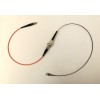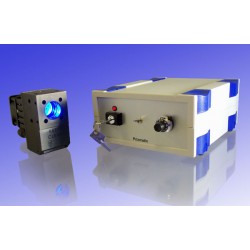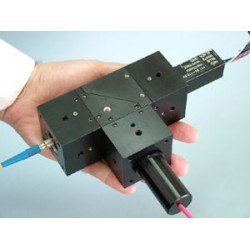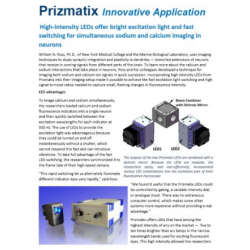In-vivo Optogenetics Products


























- Stock: Contact us for details
- Click here to: Contact us
- Model: Prizmatix Optogenetics Products
Setups for Optogenetics
In-vivo products for optogenetics
Prizmatix offer a full range of modules for in-vivo optogenetics. Starting from single wavelength plug-and-go Optogenetics-LED kits, to multi-wavelength systems for activation and silencing of photosensitive and photosynthetic proteins. From light sources to cannulae and everything in between, Prizmatix can provide all the components necessary for researchers working in neuroscience - especially fiber photometry, neurobiology, biochemistry and biophysics.
Fibre-coupled Prizmatix Optogenetics-LED light sources are triggered by an external TTL input and are specially designed to provide high-power blue, green or red light for activation or silencing of various Opsins such as the light-gated Channelrhodopsin (ChR), the chloride pump Halorhodopsin (NpHR), the proton pump Archaerhodopsin (ArchT), and many others.
With better than millisecond-scale temporal precision and powers of up to 4 Watts, Prizmatix has been the researcher's equipment choice in over 140 published scientific papers.
Optogenetics-LEDs

- Violet
- > 190 mW/mm² at 405 nm
- Blue for Channelrhodopsin (ChR1, ChR2)
- > 320 mW/mm² at 460 nm
- Green for Archaerhodopsin (ArchT)
- > 120 mW/mm² at 520 nm
- Yellow for Halorhodopsin (NpHE, eNpHR3.0)
- > 85 mW/mm² at 595 nm
- Orange/Red for red shifted opsins (Jaws, Jaws-ER2)
- > 250 mW/mm² at 630 nm
- Deep Red for red shifted opsins
- > 100 mW/mm² at 650 nm
Optogenetics-LED-Dual - Dual channel device
Designed for scaling Optogenetics experiments, the Dual-Optogenetics-LED light source features two separate LED channels with independent power and switching control. The wavelength combinations can suit widely used stimulation and silencing opsin pairs, such as:

- ChR / ArchT
- ChR / C1V1
- ChR / eNpHR3.0
- Blue / Green
- Blue / Yellow
- Blue / Red
- Other wavelengths upon request
Each channel of the Dual-Optogenetics-LED based system enables bilateral activation/inhibition for significant cost savings without compromising power at implant tip.
 Optogenetics-LED-STSI – Stimulation and Silencing by same fibre
Optogenetics-LED-STSI – Stimulation and Silencing by same fibre
The Prizmatix Optogenetics-LED-STSI module is especially designed to provide Optogenetics Stimulation / Silencing to the same neural structure in freely moving mammals. The device combines two LEDs of different colours into same single output fibre.
Each LED has independent power and switching control, and the wavelength combinations can suit widely used Stimulation and Silencing opsin pairs, such as those listed above for Optogenetics-LED-Dual.
The Optogenetics-LED-STSI based system enables bilateral activation / inhibition with single device and single one-channel rotary joint for significant cost saving and without compromising power at implant tip.
Fibre Optic Accessories
Prizmatix offers a wide range of standard and customised multi-mode silica / polymer fibres as well as ferrules for optogenetics research. A Y-shaped fibre bundle is especially useful, offering the option to activate two brain hemispheres simultaneously: a 1000 µm or 1500 µm fibre is coupled to the LED and connected to a rotary joint. From the joint’s other side emerge two thin fibres which can then be connected to two separate ferrules. The light from the LED is divided equally between the two hemispheres without any loss of power.
 Rotary Joint
Rotary Joint
Prizmatix's Rotary Joint is specially designed for Optogenetics experiments with High NA detachable fibres equipped with FC connectors. The Rotary Joint has one of the highest transmission efficiencies on the market, extremely low friction, and a smooth swivel operation. The torque required for free movement is very low, under 10 µN·m, thus reducing the Rotary Joint's behavioural effect on free moving animals. This makes it suitable for even the smallest rodents. For example, mice can typically tolerate torques up to 150 µN·m. The Prizmatix Rotary Joint can be used with single or multiple output fibres simultaneously, enabling concurrent delivery of light to separate areas of the brain without loss of power or brightness.
 Single/Dual Fibre
Single/Dual Fibre
Prizmatix provides a full solution to the optogenetics in vivo and in vitro fibre optics. Made of silica or polymer fibres, the high NA fibres are assembled to fit any research set-up with various combinations of connectors, ferrules, core diameters and lengths. Some examples are Y-shaped fibres for simultaneous in-vivo stimulation of two hemispheres, and fibres with stainless steel tip with protruding bare fibres for in-vitro activation of brain slices under a microscope.
 Implantable Cannulae
Implantable Cannulae
Prizmatix Implantable Fibreoptic Cannulae / Ferrules allow direct light stimulation of certain deep brain regions in living animals. Each cannula consists of a zirconia ferrule accommodating a high NA Silica optical fibre, protruding from the zirconia ferrule at a desired length. These can be supplied ready made, or in kit format for custom self-assembly.
 Sleeves for Implantable Cannulae
Sleeves for Implantable Cannulae
Prizmatix offer small sleeves that enable proper alignment and connection between the optogenetics' fibre ferrule and the implant (cannula) ferrule. The sleeves are available in two sizes, 1.25 and 2.5 mm diameters, manufactured from a choice of ceramic or metal.
Optogenetics Accessories


The Pulser USB to TTL interface box with user-friendly software is an easy and inexpensive way to visually program trains of pulses for Optogenetics activation directly from your computer. Includes all necessary software and cables.
Pulser Plus adds an additional output for activation of other devices after a pulse train sequence completes. It also offers control of up to 8 Prizmatix Optogenetics-LEDs via BNC-T connectors, and stand-alone operation.
Need eye protection?
| File Name | Size | Link |
|---|---|---|
|
|
385.06KiB | Download |
|
|
502.19KiB | Download |
|
|
279.26KiB | Download |
|
|
462.72KiB | Download |
|
|
547.85KiB | Download |
|
|
434.51KiB | Download |
|
|
461.45KiB | Download |
|
|
530.53KiB | Download |
|
|
573.32KiB | Download |
|
|
558.21KiB | Download |
|
|
521.66KiB | Download |
|
|
360.83KiB | Download |
|
|
641.82KiB | Download |
|
|
207.42KiB | Download |
Research papers
Hundreds of papers have been published by scientists around the globe who have used Prizmatix equipment within their research. They are listed here on the Prizmatix website.
What is Optogenetics?
Discover how light and neuroscience work together to further medical research in this article from The International Society for Optics and Photonics (SPIE):Optogenetics: Illuminating Our Head Space.










